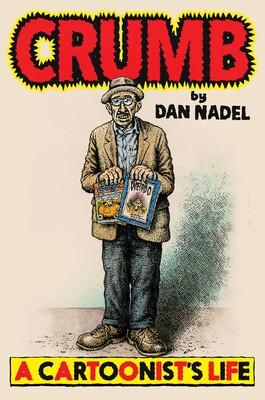Crumb: A Cartoonist’s Life, a new biography by the curator and critic Dan Nadel, wades into Crumb’s psyche. Whereas Crumb the documentary plays out like a grimy picaresque, Crumb the book is orderly and analytical, as much a history of underground comics as a pathology of Crumb. Nadel argues that Crumb is one of the “most profound and influential artists of the twentieth century,” a claim that would have been unthinkable in the 1960s. His profundity is partly a function of ruthless introspection; the same impulse that drives Crumb to admit his sexual compulsions also spurs him to unleash his scabrous vision of society, along with gentler family portraits and slice-of-life vignettes. His technical virtuosity and imaginative range transcend the ephemerality of single-gag comics. Crumb’s work chronicles the pressures of modern life on the groin and nervous system of one highly vibratory man.
Nadel distills Crumb’s obsessions as “Mommy; powerful women; acceptance; revenge.” Of this quartet, revenge may be the purring motor of Crumb’s universe. In a screed titled “The Litany of Hate,” included in the compilation The R. Crumb Handbook, from 2005, he pinpoints his antagonists: mass media, contemporary pop music, architecture post-1955, organized religion, government, nature, and humanity itself. Even his Dust Bowl wardrobe—tweed jacket, cuffed trousers, fedora—personifies his style of vindictive nostalgia. Crumb feels like a man out of sync, dislocated, and yet perfectly calibrated to channel modern America’s psychoses.
Nonetheless, Robert Crumb was born at a fortuitous moment: specifically, Philadelphia, 1943. As Nadel notes, the late 1940s and early ’50s were the comedown of a long comics heyday that included Little Lulu, Pogo, Walt Disney’s Comics and Stories, Dick Tracy, and DC Comics superheroes. Horror comics—The Vault of Horror and Tales From the Crypt, among others—were just rolling off the presses, along with the debut of Mad magazine with its subversive spoofs. Following the atrocities of World War II, Nadel suggests that comics “became a place to cram all the PTSD, atomic anxiety, and existential fear that could fit between two covers.” This work so scandalized the nation’s taxpayers that Congress convened hearings on the dangers of comics in 1954. As a result, the industry adopted a code of ethics that Crumb and others would giddily dismantle in the coming years, including the injunction to nix all scenes of “depravity, lust, sadism, masochism.”
